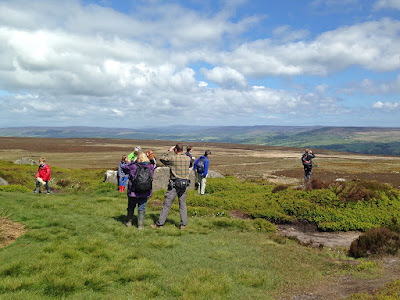Our plan was to look for specialist moorland birds - ones adapted to live and breed on the exposed hills. One such bird is the Red Grouse, and it wasn’t long before one flew up from the heather beside the path and landed on a nearby wall, letting out its croaky call as it flew. These birds are adapted to keep warm and dry in cold upland areas, having round, stocky bodies with feathers covering their legs. The bird we saw appeared to be a male - these have a much brighter red “comb” above their eyes, which becomes even brighter during the breeding season.
Typical of view of a Red Grouse, hiding in the heather
Many wading birds breed on moors, such as Redshank, Curlew, Lapwing, Snipe and Golden Plover. Most people associate waders with wetlands, mudflats and the seashore. Their long legs are adapted for wading in shallow water and their long bills for probing mud and sand. Moors are often very wet and marshy, and can also be have quite sandy soil, allowing the long-billed waders to feed effectively.
A Lapwing frequently flew above us as we walked, calling as we passed a his territory, giving us great views of this beautiful bird. Sadly, the British Lapwing breeding population has been declining for a number of years, probably because of changes to farming methods. All around us we could hear the fabulous call of the Curlew - a very evocative moorland sound. We saw several flying and calling nearby, proclaiming their territories.
Curlew, Baildon Moor (photo: Paul Marfell)
Another bird we wanted to see was the Red Kite, and it wasn’t long before Cam spotted two in the distance towards Bingley. But soon after we saw another, and much closer. A majestic bird of prey, and becoming more common in Airedale since they've been reintroduced into nearby Wharfedale over the last couple of decades. Unlike most raptors, Red Kites don’t catch and kill much live prey, other than some small mammals, young birds, and earthworms. They scavenge for carrion - dead animals - on moors and farmland and by the roadside.
Red Kite, Rombalds Moor - Sunday, 7th June 2015
Watching Red Kites and Lapwing
Another bird we wanted to see was the Golden Plover, a beautiful black, white, and golden-brown bird, and a close relative of the Lapwing. We settled down by some rocks and scanned a flat area of moorland below us. We could hear the birds, making their sad-sounding “peoo” calls, but couldn't see them. We could also hear the songs of Meadow Pipits who, like Skylarks, sing as they rise into the the air.
Looking for Golden Plovers
A welcome surprise while we were looking for the Golden Plovers was a Green Hairstreak butterfly. In the north of England these butterflies specialise on living on moors and bogs. They have dark brown upper wings, but when they are at rest they close their wings to reveal the bright green underside.
Green Hairstreak, Rombalds Moor - Sunday, 7th June 2015
Photographing the Green Hairstreak butterfly
Another really interesting and enjoyable walk, with plenty to see and learn.








No comments:
Post a Comment